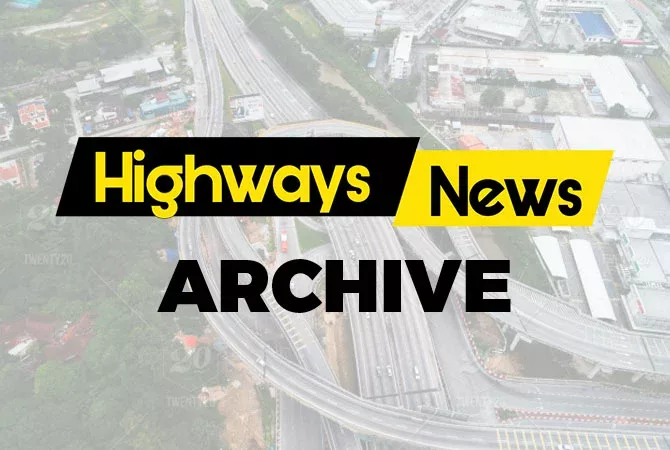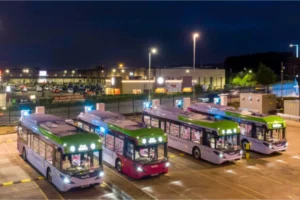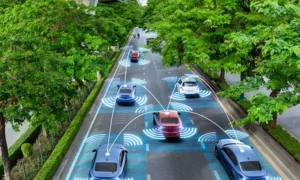Clearview Intelligence’s Client Relationship Manager, Simon Waterfall, is trying to take new technology to the next level. Here, he talks to Adrian Tatum about how using the right technology can lead to better decision making and more effective outcomes.
Simon Waterfall is a man on a mission. He wants to continue to ensure innovation is at the forefront of technological development in the highways and transport sector, the kind that can make a real difference to the way the industry thinks and works, not just the kind that is a form of something else that already exists, something he finds frustrating about this industry at times.
When I told an industry colleague (and former colleague of Mr Waterfall) that I was interviewing him and asked him for his comments, he agreed. “Simon is unusual. And that is a massive positive. He has progressed from working as field service engineer through self-motivation, purpose and an unquenchable ‘have a go’ attitude. People warm to Simon and buy into him. He repays that faith. His operational understanding of highways sets him apart from many of his peers. He’s achieved a lot but is humble and self-aware. He surrounds himself with other, clever hard-working people because he prides himself on someone who just ‘gets it done’.
“I know the Highway Technology sector frustrates him with its slow rate of change, intransigence and lack of collaboration when it should be leading the way in transforming the highways sector. And so it should frustrate him. Some disruption is required in the ITS sector. Simon can be part of that.”
But does he agree?: “The problem we find ourselves in is, we are now in the amazon era. You want that new song, download it in seconds. You need some food-Just Eat. Your TV has broken-its delivered the same afternoon. How we live in this fast-paced environment and then go to work at night and cut a loop in the road or trench miles and miles of ducting to get electricity to power hungry 1970’s delivered equipment, that just isn’t right.
“The ITS industry has to get together and push the boundaries of what is possible. There seems to be the relentless sausage machine of tier 1 contractors and I have been one of them, where they say ‘we do it like this-so let’s cut and paste’. But people need to take a step back and ask will it make the boat go faster by regurgitating the same old solutions?”
The truth is, whatever way you look at it, Clearview has a real asset with Mr Waterfall in its ranks now. He was instrumental during his time at Kier in working closely with Highways England as his client for over 10 years and brings a wealth of experience to Clearview having previously worked at Amey. This means he has now built an extensive portfolio of innovative solutions to meet with the challenges of delivering services on the Strategic Road Network. More recently he has been integral with the new and emerging technologies for Connected and Autonomous Vehicles and Renewable Energies that will inform Highways England’s expressway standards going forward as well as developing various new products through Highways England’s Designated Fund.
Now he is currently working on a number of projects including the on-going development of Clearview’s M100 magnetometer to help aid more rapidly deployable roadside infrastructure. Proof as well, that sometimes it is the simplest of introductions that can make a difference. Here, a new cabinet has been implemented with an integral pole meaning one doesn’t have to be dug elsewhere. “This will help towards Highways England’s massive ask to reduce both carbon and make more efficiency savings by limiting the amount of metal work at the side of the road and is a positive nod towards the leaner, greener aims of the Industrial Strategy,” he adds. The product is being used as part of the Smart Motorway Alliance’s approach to deploying new innovation.
Clearview’s Insight software platform is also integral to reducing the need for physical infrastructure. Insight can help bring together Clearview’s journey time, parking and count and classify system but now also with the integration of CCTV, environmental monitors with VMS signs. “Insight brings together a number of powerful, accurate data sources while significantly reducing the need for physical infrastructure. It is this kind of flexible and integrated data intelligence system that people are demanding more and more because it enables users to use one or all of the component parts at a given time to help improve decision making on the network,” he says.
Mr Waterfall is currently working on an important project with Highways England focusing on how vulnerable road users can detected on the network. This alongside other safety related innovations in the planning stage points towards a fruitful time ahead for new technology?
“All innovations are important, but I guess even more so now as we enter a new way of working as a result of covid and the ongoing need to drive efficiencies. Something else we are working on is making sure these technologies we are delivering are low-powered solutions to ensure more solutions are powered by renewable energy,” says Mr Waterfall. “But yes, we want to be seen to be leading the way with providing new solutions to on-going challenges on the network,” he adds.
Clearview is now looking at solutions suitable for a semi post-covid environment. “An example of this is our development of wearable technology for strategic road workers that have the capability to track and trace to help reduce the risk to sites to avoid them closing,” he says. There is also a focus on people and plant interface, vehicle incursion monitoring and providing information to the travelling public moving through large works.
“There is a lot more we can do as an industry to help people understand what we do in this industry and how we do it and therefore do more to protect our roadworkers,” he adds. “That will take solutions that can both provide further safety enhancements for the workers themselves as well as ones that provide a constant drip of accurate, real-time information for the travelling public.”
This all underlines the fact that Clearview is now much more a solutions-based company than ever before. Underpinning all of this will be Clearview’s new Connex platform.
Clearview Intelligence provides software and hardware technology platforms and design services for active travel, network optimisation, route safety and parking. Its new Connex Active and Connex Traffic solutions include pedestrian/cycle classification and count, wireless vehicle detection and real-time vehicle counters. Clearview’s Connex Link is a communication and control solution for a variety of application and enables the system to trigger devices, such as Variable Message Signs (VMS). For carriageway and footway delineation, it provides both solar powered road studs, SolarLite, and also its IRS intelligent road studs for more dynamic delineation.
“Connex will provide the universal footing for any of our solutions moving forward. It has a 4G daughter board, is powered by an ultra-low solution of sub 1 Watt. It will provide that umbrella platform and one that is stable, well developed and well tested using open protocols meaning that other software and hardware platforms can be connect so that the user is not beholden to one particular platform,” says Mr Waterfall. Connex is ideal for local roads as well as strategic. Clearview is working towards using its count and classify technology to enable data from all the different active travel modes to be put together showing an accurate, city-wide view on what is happening on the network.
But how much of the technology being developed in general for the strategic network is transferable to the local? “I think more could be done to encourage that. The point is as well that some of the development work already been done by the tier 1 contractors could well be suitable for their own local authority contracts as well. But we are starting to see more innovation in technology used on local roads. Also Highways England are looking at investing in areas and regions from a more holistic approach which has seen them invest in local roads to and work more closely with local authorities and we still hope to see progress being made on the Mayor Route Networks as well which will provide more investment in technology used on the local network. I think that has always been a dynamic approach to local roads to be honest but having said that there is more we can do. The big question here is how can we ensure that technology that is driving both efficiency and effectiveness can be affordable to local authorities?”
“What would be helpful is for local authorities to come out with their problem statements and challenges in a more open way that encourages technology providers to find a way to develop a solution to those. It maybe a solution has been found already or there is an industry partner that can part fund the solution they need or find a way of funding that solution,” he adds.
Above all else Mr Waterfall is keen to cut through the slow rate of change and in some cases, lack of industry collaboration (as described by his former colleague earlier on in this article) to ensure the highways sector is being transformed and remains at the forefront of being able to use technology
“Clearview is in a really strong position to be able to be able to help with this and play its part in not only keeping the local and strategic networks safe and effective but transferring that knowledge and technology between the two. Whether you are managing the local or strategic network, real-time, accurate data is key to informing better decisions and that is what we will be clearly focused on in the future.” He adds.





















